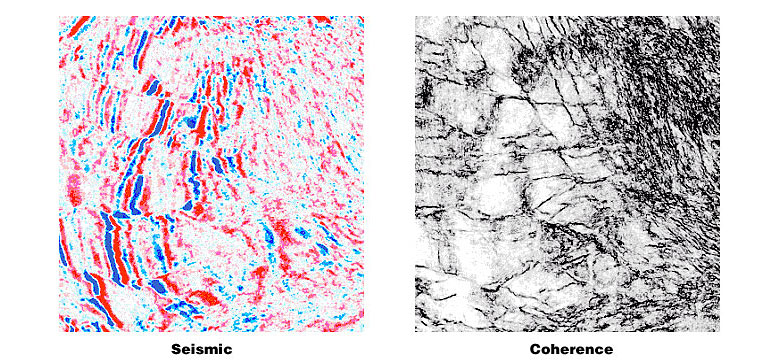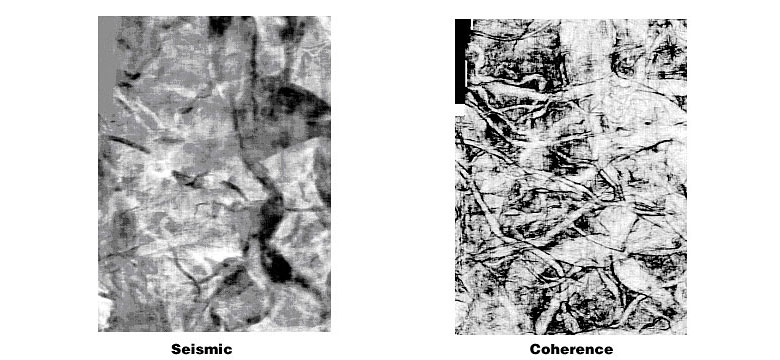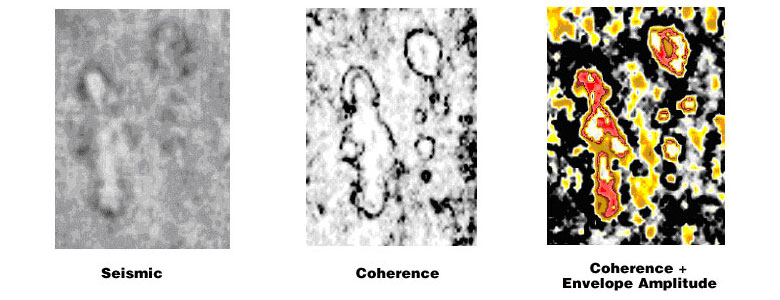Abstract
Since the introduction of three-dimensional seismic technology, there has been an ongoing effort to refine and improve its potential. One such attempt was the development of coherence processing which has made a significant contribution to 3D seismic interpretation. Coherence measurements on seismic traces represent changes in local waveforms and therefore produce interpretable images. Similar traces are mapped with high coherence coefficients and discontinuities are inferred where similarity ends. Stratigraphic features generate similar discontinuities resulting in sharp detection of channel boundaries and deltaic sediments that are often not visible in traditionally processed data. Traditional time slices can be used to interpret faults in the dip direction, but faults parallel to strike may not be picked up at all. Coherence data volumes offer an unbiased interpretation of faults (in any orientation) and other features, which may be included in horizon maps. Barely perceptible impressions on stacked/migrated seismic volumes show up as distinct and subtle features with clear areal extent. In addition to detection of faults (Fig.1), channels (Fig.2), beaches, etc. seismic coherence has been successfully used for easy visualization of mud volcanoes, mass wasting, dewatered features, glacial scouring, reefs (Fig.3) and other pop-up features. Another effective application of coherence is for shallow hazard detection in the near surface. Such interpretations constrain subsequent well construction plans and reservoir and flow simulations and bring added confidence levels in decisions.



An important application of coherence is in the merging of coherence attribute values or inverted acoustic impedance values with coherence coefficients. This not only helps in the identification of the nature and extent of deposition but also helps gain understanding of the depositional environment. Similarly, acoustic impedance changes can be readily identified within sedimentary systems.
Apart from the post-stack applications, coherence is a useful complimentary tool during processing of the seismic data. Coherence values are computed on 3D stacks with different parameters at each stage, and those values which best focus the target zone(s) are selected. The data volumes are analyzed by slicing through the target zone. Such slices are used as diagnostics for quality control at the residual statics stage (i.e. before and after), DMO, Prestack migration, AVO, etc. Breaks or striations observed on the slices in the inline or crossline direction could emphasize problems in processing, e.g. in the shooting geometry or disharmonization of statics in-between swaths, etc. This procedure not only helps to concentrate on the zone of interest but also helps to tune in the parameters to focus the zone with clarity. After stack, velocity moderation for migration and effectiveness of noise attenuation techniques are evaluated by coherence.
Coherence can be utilized successfully for detection of faults and fractures in prospects where they are not so evident on the seismic data volumes, but indirect evidence (from well data or geological setting of the subsurface) suggests their existence. This approach is significant for identification of zones where productivity is influenced by fractures and faults.
Biography
Satinder Chopra specializes in coherence and seismic inversion processing at Scott Pickford, Calgary. He earned his M.Sc. and M.Phil. degrees in Physics from Himachal Pradesh University, India. Employed by Oil and Natural Gas Corporation Ltd. (ONGC) in 1984 he worked as a Processing Geophysicist, Special Projects Geophysicist and Senior Geophysicist for interactive interpretation of marine data. In 1994 he was appointed as Head of Management Services Group at GEOPIC (Geodata Processing and Interpretation Center), the biggest computing facility of ONGC. He joined Scott Pickford, Calgary in 1998 where he has been involved with demonstrating the advantage of adding the coherence dimension to seismic data. Satinder has delivered numerous presentations on coherence, special processing and interpretation of seismic data. He has written many papers and three books. He edited the Conference Proceedings for the First International Conference of the Society of Petroleum Geophysicists, India. He is a member of SEG, CSEG and EAGE.





